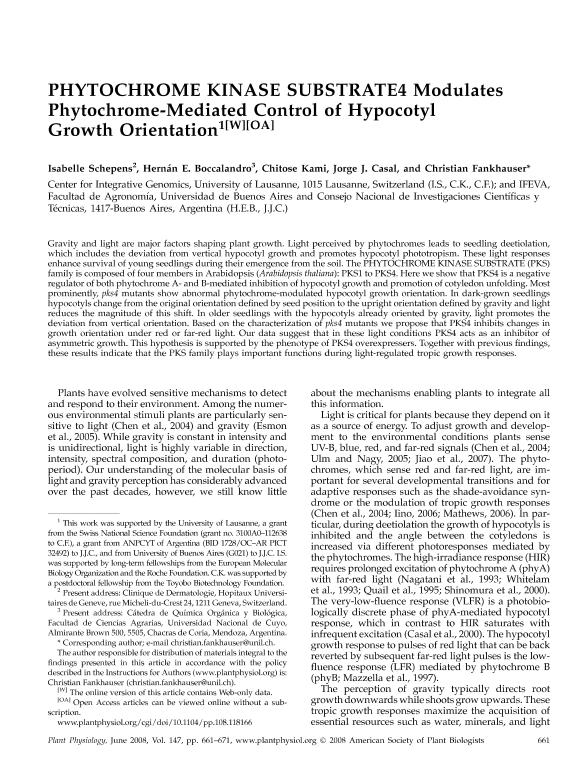Mostrar el registro sencillo del ítem
dc.contributor.author
Schepens, Isabelle
dc.contributor.author
Boccalandro, Hernan Esteban

dc.contributor.author
Kami, Chitose
dc.contributor.author
Casal, Jorge José

dc.contributor.author
Fankhauser, Christian
dc.date.available
2021-03-12T17:45:15Z
dc.date.issued
2008-06
dc.identifier.citation
Schepens, Isabelle; Boccalandro, Hernan Esteban; Kami, Chitose; Casal, Jorge José; Fankhauser, Christian; Phytochrome Kinase Substrate4 modulates phytochrome-mediated control of hypocotyl growth orientation; American Society of Plant Biologist; Plant Physiology; 147; 2; 6-2008; 661-671
dc.identifier.issn
0032-0889
dc.identifier.uri
http://hdl.handle.net/11336/128255
dc.description.abstract
Gravity and light are major factors shaping plant growth. Light perceived by phytochromes leads to seedling deetiolation, which includes the deviation from vertical hypocotyl growth and promotes hypocotyl phototropism. These light responses enhance survival of young seedlings during their emergence from the soil. The PHYTOCHROME KINASE SUBSTRATE (PKS) family is composed of four members in Arabidopsis (Arabidopsis thaliana): PKS1 to PKS4. Here we show that PKS4 is a negative regulator of both phytochrome A- and B-mediated inhibition of hypocotyl growth and promotion of cotyledon unfolding. Most prominently, pks4 mutants show abnormal phytochrome-modulated hypocotyl growth orientation. In dark-grown seedlings hypocotyls change from the original orientation defined by seed position to the upright orientation defined by gravity and light reduces the magnitude of this shift. In older seedlings with the hypocotyls already oriented by gravity, light promotes the deviation from vertical orientation. Based on the characterization of pks4 mutants we propose that PKS4 inhibits changes in growth orientation under red or far-red light. Our data suggest that in these light conditions PKS4 acts as an inhibitor of asymmetric growth. This hypothesis is supported by the phenotype of PKS4 overexpressers. Together with previous findings, these results indicate that the PKS family plays important functions during light-regulated tropic growth responses.
dc.format
application/pdf
dc.language.iso
eng
dc.publisher
American Society of Plant Biologist

dc.rights
info:eu-repo/semantics/openAccess
dc.rights.uri
https://creativecommons.org/licenses/by-nc-sa/2.5/ar/
dc.subject
phytochrome
dc.subject
Arabidopsis thaliana
dc.subject
Seedling
dc.subject
Growth
dc.subject.classification
Otras Ciencias Agrícolas

dc.subject.classification
Otras Ciencias Agrícolas

dc.subject.classification
CIENCIAS AGRÍCOLAS

dc.title
Phytochrome Kinase Substrate4 modulates phytochrome-mediated control of hypocotyl growth orientation
dc.type
info:eu-repo/semantics/article
dc.type
info:ar-repo/semantics/artículo
dc.type
info:eu-repo/semantics/publishedVersion
dc.date.updated
2020-05-19T19:03:35Z
dc.journal.volume
147
dc.journal.number
2
dc.journal.pagination
661-671
dc.journal.pais
Estados Unidos

dc.journal.ciudad
Rockville
dc.description.fil
Fil: Schepens, Isabelle. Universite de Lausanne; Suiza
dc.description.fil
Fil: Boccalandro, Hernan Esteban. Consejo Nacional de Investigaciones Científicas y Técnicas. Centro Científico Tecnológico Conicet - Mendoza. Instituto de Biología Agrícola de Mendoza. Universidad Nacional de Cuyo. Facultad de Ciencias Agrarias. Instituto de Biología Agrícola de Mendoza; Argentina. Universidad Nacional de Cuyo; Argentina
dc.description.fil
Fil: Kami, Chitose. Universite de Lausanne; Suiza
dc.description.fil
Fil: Casal, Jorge José. Consejo Nacional de Investigaciones Científicas y Técnicas. Oficina de Coordinación Administrativa Parque Centenario. Instituto de Investigaciones Fisiológicas y Ecológicas Vinculadas a la Agricultura. Universidad de Buenos Aires. Facultad de Agronomía. Instituto de Investigaciones Fisiológicas y Ecológicas Vinculadas a la Agricultura; Argentina
dc.description.fil
Fil: Fankhauser, Christian. Universite de Lausanne; Suiza
dc.journal.title
Plant Physiology

dc.relation.alternativeid
info:eu-repo/semantics/altIdentifier/url/http://www.plantphysiol.org/content/147/2/661
dc.relation.alternativeid
info:eu-repo/semantics/altIdentifier/doi/https://doi.org/10.1104/pp.108.118166
Archivos asociados
